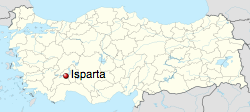*a Living dance is a 1st Generation dance that is still performed in the country of origin (or immigrant communities) as part of a social event like a wedding where others can participate (not for an audience) by people who learned the dance informally (from friends and relatives by observation and imitation, not in a classroom situation). For more information, click here and here.
Turkish dance authority Metin And, in his 1976 book A Pictorial History of Turkish Dancing, says: “Kaşık Oyunu (Spoon Dance) is the most popular dance in Central Anatolia. Dancers carry in each hand, a pair of varnished wooden spoons, one of which is inserted between thumb and forefinger and the other between the middle and ring finger- in this position they are clicked like castanets. The dancer treads with very small steps in a confined space while undulating the lower part of the body.

“The formation of kaşikli dances varies and is done in lines, circles or semi-circles. In many cases, the dancers are face to face as they dance apart, their hands clacking the backs of the bowls of the spoons together.” Source: https://tayyarny.blogspot.com/. Judging from the many YouTubes I’ve seen, most kaşık oyunu are either all men or all women. Occasionally I’ve seen men and women dancing in the same room, but not man-to-woman. The only exception seems to be a special bride-groom dance at a wedding.
I find it difficult to find much information on kaşik oyunu in English. From the fragments I’ve found, it appears dances using spoons were originally by women only, as a rhythmic accompaniment to traditional songs. The example above shows two women dancing the small steps described by Metin And, while mirroring each others’ movements. The dances below are described as Turkmen – implying they came to Anatolia with nomadic tribes from Central Asia. Consider this statement: “Many of the spoon dances from Silifke, (see bottom of article) located along the Mediterranean coast, features spoons with which the dancers click out a lively rhythm while executing quick, agile movements with their feet and arms. Frequently, the songs tell of the migratory Turkmen people. The lyrics describe their nomadic journeys, or their daily routines when settled. Their arm movements are prominent, as is often the case in dances that incorporate accessories, such as handkerchiefs or tools.” Source: https://tayyarny.blogspot.com/
For more on the origins of the Turks and how they got to Anatolia, click https://folkdancefootnotes.org/culture/ethnicity-history-geography/turks-who-are-they-how-did-they-get-to-anatolia/
The women below use special spoons carved for dancing only.


The Turkmen may well have brought their spoons and spoon dancing with them, but dancing to clackers [the informal name for the family of instruments where sound is made by hitting two of the same thing together] existed in Anatolia (Phrygia) 2000 years before the Turks arrived. See: https://folkdancefootnotes.org/culture/ethnicity-history-geography/ankara-history-dances-and-fauna/

For more on the origins of various clapper instruments (spoons, bones, castanets, zills, etc,) click: https://folkdancefootnotes.org/music/2a-clappers-krotala-kasik-spoons-castanets-zills/
Metin And (1976) continues: “Another well-known spoon dance is from Bolu. The dancers start by saluting the onlookers. This salute consists of crouching, touching their spoons first on the ground then on their chins and then on their foreheads. Then the dancers face each other in pairs, they approach, recede, kneel and turn.“



Musician: Ankarali Fedail https://www.youtube.com/watch?v=dSCOvUc2lXQ






In the town of Dinar, the spoon dance is generally performed by young girls at entertainment festivities, engagement and wedding ceremonies, in addition to the colorful costumes, the dancers have pair of spoons in each hand. Accompanying instruments: Uc telli, Zurna and Baglama. Source: https://tayyarny.blogspot.com/

Silifke
Moving along the eastern Mediterranean coast to Silifke, pine forests and orange groves descend to sandy beaches, which was a wedding present to Cleopatra. In the regional “Spoon Dance” performers are gaily dressed, male and female dancers clicking out the dance rhythm with a pair of wooden spoons in each hand. Source: https://tayyarny.blogspot.com/


Other names for dances with spoons: “bengi”, “mengi”, “guvende”. Source: https://web.itu.edu.tr/~aksind/Personal/tfd.html
For a look at modern Turkey’s Kasik-Breakdance fusion, click below.
